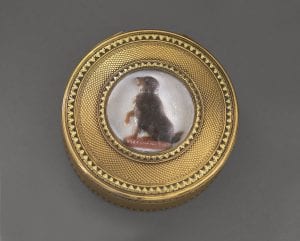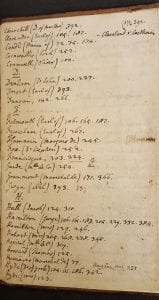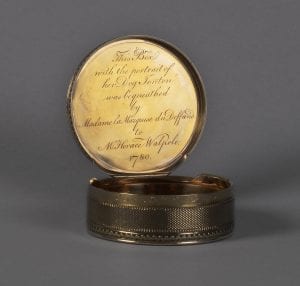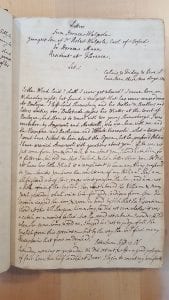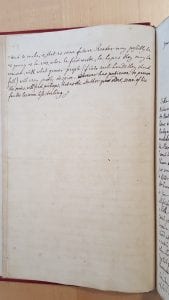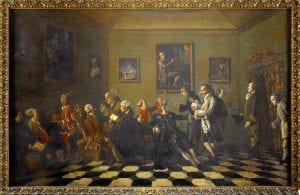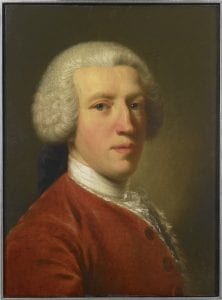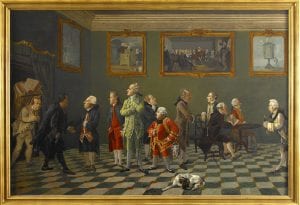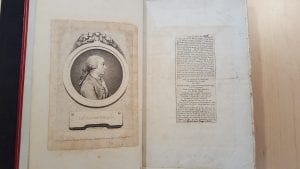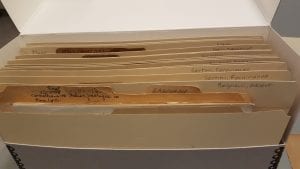29. Horace Walpole and Macaroni Fashion Fads
by Peter McNeil, Distinguished Professor of Design History, University of Technology Sydney
Distinguished Professor, ‘FiDiPro’, Aalto University/
Professor of Fashion Studies, Stockholm University
Scholarly and also popular awareness of the ‘macaroni man’ has gained momentum among not just those interested in the fashion culture of the eighteenth century but the general public more widely. In an era that is questioning both gender binaries and boundaries, the ambiguity, playfulness and whimsy of macaroni men is just too powerful to ignore. Variously mocked as libidinous or sexually inept, ‘amphibious’ (a term used by Pope in the Dunciad – meaning ‘leading two lives’) or even ‘neuter’, he was an important masculine figure between the better known types of the French fop and the Regency English Dandy. The increasing attention to him reflects the growth of inter-disciplinary research into masculinity, consumer practices, print culture and sartorial fashions, as well as the new, keener interest in specific episodes of men’s dress, hitherto a somewhat neglected topic. Studying the macaroni over the past twenty years, including on two visits to the Lewis Walpole Library, I have woven together dress, biography, historical events and art spanning genres from the scurrilous caricature to respectful portrait. Celebrities hailed or mocked as different as the politician Charles James Fox, the painter Richard Cosway, the freed slave Julius ‘Soubise’ and the white collar criminal Reverend Dodd demand such an approach. Indeed it is possibly the eccentric amalgam of fashion-forward men from different social groups and milieux, often with startling life stories, that attracted the eye and pen of Horace Walpole more than 200 years ago, then much later the notations crafted by W.S. Lewis and his research team in Farmington, Connecticut working on Walpole’s Letters in the inter and post-war years of the twentieth century. The circle around W.S. Lewis including Sir Francis Watson did much to investigate the cultural meanings of eighteenth-century men’s dress in the 1960s, a time when the study was barely on the academic radar in the USA or UK [i] . Dress and fashionability was clearly of interest to Lewis, being the subject of many entries in the card catalogue, topic of many incursions in the annotated Letters of Walpole and referred to in the work of other associated authors such as Lars E. Troide.
Researchers now resist reading the macaroni as simply illustrative of something occurring in eighteenth-century life, for example, a particular world-view such as aristocratic excess or anxiety concerning war and the role of militia. Several reasons can be advanced for this shift. The first is the changing attitude towards the interpretation of caricature prints as complex visual artefacts; the second is the reassessment of dress fashion as an area of serious research within cultural history. Being fashionable or looking in turn at fashionable people is part of a complex power relationship that still fascinates today. Over the course of the eighteenth century fashion contributed to new ideas of self, personality, celebrity and spectatorship, all of which was both subject for and in turn amplified by the greatly increased incidence of satirical and other prints sold by canny print-seller entrepreneurs.
What does Horace Walpole and his archive tell us about the macaronis? Dictionaries note that the first recorded use of the term ‘macaroni’ occurred in the voluminous correspondence of Walpole, although this is not strictly true. Similar words had been used as names of characters in Garrick’s plays as early as 1757. Walpole’s trenchant eye did, however, provide the first detailed surviving impression of this phenomenon when it appeared amongst the aristocracy in London. It was something new. In February 1764 Walpole observed gambling losses amongst the sons of foreign visitors (Lewis’ team thought them to be Modenese men) at the ‘Maccaroni club, which is composed of all the travelled young men who wear long curls and spying-glasses’. This youth fashion was for shorter suit jackets which showed more of the rear (leading to moral condemnation at many times in history), striped or coloured silk stockings, red-heeled, slipper-like and thin-soled shoes, some with rosettes (thus alluding to the French court and only suited for city life), small, impractical tricorn hats, often carried not worn (known as ‘Nivernais’ or ‘Nivernois’ after the French Ambassador in London – the translator of Walpole’s essay on gardening into French), very large floral corsages at the bosom, a hanger-sword, pocket-watch and seals hanging from the waist, sometimes with a dummy watch (fausse-montre) for symmetry, canes, parasols (normally used by women in England at this date), and other luxury accessories such as steel buttons and shoe buckles, metal or enamel snuff and patch boxes and many types of magnifying glasses. The colours preferred were pastels from yellow to orange but also buff and blue, small spotted or chevron textiles (not the larger woven florals of earlier periods) and high quality silk, velvet or woollen broadcloth (the latter being plain and never printed).

(M. Darly, The St. James Macaroni, 12 August 1772. The Lewis Walpole Library, Yale University)
Particular attention was paid to embroidered and trimmed waistcoats which were once described as having all the ‘debris of a magazin de mode’. Profligate gaming, associated with continental and specifically French manners, was strongly associated with the macaroni type. Gaming was highly fashionable and losses had reached epidemic proportions; Charles James Fox’s stakes of £3000 and total gambling debts of £140, 000 were public knowledge, mentioned in macaroni ditties and satires. Walpole, listing the things in the world that were best worth finding, included the longitude, the philosopher’s stone, the certificate of the Duchess of Kingston’s first marriage, the missing books of Livy, ‘and all that Charles Fox had lost’. Gaming and expenditure on fashion were a good fit, as the idea emerged that the endless cycle of fashion change would weaken men’s natural reserve as well as resources and lead to a type of fiscal and moral exhaustion.
A particular type of dress was associated with the inveterate gambler. The English made a ritual of their dress at the private clubs. Walpole noted:
They began by pulling off their embroidered clothes, and put on frieze great coats, or turned their coats inside outwards for luck. They put on pieces of leather, such as are worn by footmen when they clean the knives, to save their laced ruffles; and, to guard their eyes from the light, and to prevent tumbling their hair, wore high-crowned hats with broad brims, and adorned with flowers and ribbons.[ii]
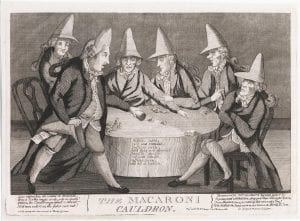
(The macaroni cauldron, To be had with many other Macaronies pubd. by MDarly (39) Strand. [London]: Pubd. accordg. to act March 9, 1772, by MDarly, 39 Strand, [1772]. The Lewis Walpole Library, Yale University)
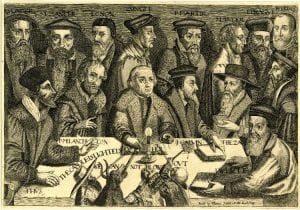
The candle is lighted, we cannot blow out c1640 (British Museum)
Men spent such long hours at the table that an engraving depicted a special cap with a wide rim, worn to protect weary eyes from bright candlelight, possibly to deter cheating. Darly’s engraving The Macaroni Cauldron shows the caps mirroring and protecting the shapes of the high toupee wigs . The way in which the men are placed around the table is reminiscent of seventeenth-century English prints of the gathering around Martin Luther, as in The candle is lighted, we cannot blow out c1640 (British Museum).[iii]. This was not ultimately the guise that came to be associated in the public mind with the macaroni; instead, the fine clothing that they were protecting beneath comprised their fashionable dress. A play review described ‘the Nabob sitting at his table in his gambling dress, the silk night gown, straw bonnet, &c. which the virtuous gentlemen of Almack’s use when at play’.[iv]
Walpole made further reference to macaronis in his Letters of 1764. In May he referred to a ‘young rich Mr Crewe‘ as ‘a Maccarone’ [sic]; in June he described a party without heating at which ‘All the beauties were disappointed, and all the macaronies afraid of getting the toothache.’[v] In November he indicated that macaroni dress was a style of the very young, when he observed at the Opera: ‘You see I am not likely, like my brother Cholmondeley… to totter into a solitaire at threescore.’[vi] Distinctive macaroni colour schemes for various seasons, probably copied from the vibrant combinations used in French and Italian silks and velvets, were indicated: ‘If I went to Almack’s and decked out my wrinkles in pink and green like Lord Harrington, I might still be in vogue.’[vii]
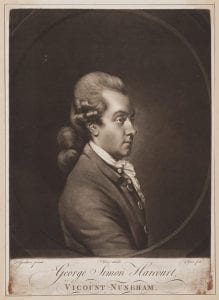
(Daniel Gardner (painter), V. Green, (printmaker), George Simon Harcourt, Viscount Nuneham, 1772 [later 2nd Earl of Harcourt of Stanton], mezzotint, 32 x 22.7 cm. The Lewis Walpole Library, Yale University. Horace Walpole’s own copy).
The key to the macaroni was excess. Walpole characterised the macaroni as sporting massive nosegays or corsages: ‘
Lord Nuneham’s garden is the quintessence of nosegays: I wonder some macaroni does not offer ten thousand pounds for it – but indeed the flowers come in their natural season, and take care to bring their perfumes along with them’.
[viii] To the Countess of Upper Ossory he wrote that Nuneham (George Simon Harcourt, Viscount Nuneham) had a
‘flower-garden that would keep all Maccaronia in nosegays’.
[ix] Walpole owned a copy of the elegant 1772 portrait by Daniel Gardner of Viscount Nuneham, which is respectful, not scurrilous, and indicates the mannerism of macaroni hair with its long tail andhigh toupee at the front.
Apart from the towering source of the annotated Letters, the Lewis Walpole Library is perhaps the most fruitful space in which to study macaroni materials. It is an invaluable source for studying unseparated macaroni prints in the editions published by the Darly’s, many hand coloured, which were interwoven with other topical themes and jokes. Walpole’s personal scrapbook of 280 etchings, prints and drawings assembled by him between 1776 and 1782 includes an undated sketch, likely by Bunbury, in which a finely dressed macaroni is tailed by a child beggar.[x]

(‘THIS CLUB was instituted and kept at ALMACKS and called the MACCARONI [sic] society’, pen and ink drawing on tracing paper, in ‘Etchings by Henry William Bunbury, Esq. and After His Designs’; album collected by Horace Walpole, 2 vol. fol. 49/3563./v.1.2, at p. 2. LLWL 765 0 85dr. The Lewis Walpole Library, Yale University)
Bunbury, or another hand, noted beneath the sketch: ‘THIS CLUB was instituted and kept at ALMACKS and called the MACCARONI [sic] society.’
[xi] Walpole linked Almack’s with the macaroni several other times in his correspondence; there were
‘Macaronis lolling out of windows at Almack’s like carpets to be dusted’.
[xii] Furthermore,
The Macaroni and Theatrical Magazine also referred to Almack’s, describing: ‘a compound dish of vermicelli and other pastes, which, unknown in England until then, was imported by our Connoscenti [sic] in eating, as an improvement to their subscription table at Almack’s’.
[xiii] Walpole’s description of the macaroni club was designed to amuse his correspondents who were familiar with the ambience of these Whig establishments, notorious for gaming, feasting and carousing. The Edwardian biographer of the macaroni Walter Stanhope noted that macaroni was ‘always placed on the table at their dinners’; he had access to his papers but did not otherwise note the source of this claim.
[xiv] Almacks was later known as the ‘Scavoir Vivre’, an expression which occurs in comic journals of the period that include macaroni men.
[xv]
References to macaroni in terms of luxury, fashion or folly, can be found in letters dated 1772 and 1773, and the connection in Walpole’s mind with the extravagant Whig circle around Charles James Fox was confirmed in July 1773. The macaroni became metaphor for problems with the currency and a general draining of the economy:
Ireland is drained and has not a shilling. The explosion of the Scotch banks has reduced them almost as low, and sunk their flourishing manufactures to low water ebb. The Maccaronis [sic] are at their ne plus ultra: Charles Fox is already so like Julius Caesar, that he owes an hundred thousand pounds… What is England now? – A sink of Indian wealth, filled by nabobs and emptied by Maccaronis! A senate sold and despised! A country over-run by horse-races! A gaming, robbing, wrangling, railing nation, without principles, genius, character or allies; the over-grown shadow of what it was!.[xvi]
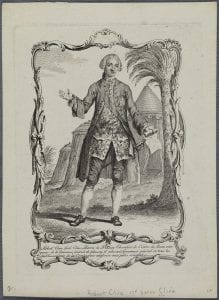
(Unknown, Robert, Lord Clive Baron de Plassey Chevalier de l’order du Bain, vainqueur de la fameuse journée de plassey, et cidevant Gouverneur général de tous les établissements de la Compagnie angloise aux judes orientales. The Lewis Walpole Library, Yale University)
Walpole, as usual, exaggerated; he continued; ‘Lord bless me, I run on like a political barber – I must go back to my shop…’[xvii] An example of the Oriental richness and luxury that Walpole refers to may be seen in the engraving Robert Clive, Lord Clive Baron de Plassey… Gouverneur général de tour les établissements de la Compagnie angloise aux judes orientales. This plate is a good example of the incredibly varied and rich collection of loose prints, possibly once clipped from another source, acquired by W S Lewis from dealers in London, New York and elsewhere. Clive of India’s rich court dress matches the elaborate rococo frame, suggesting general richness and luxury with a palm tree and campaign tents indicating the foreign location.
Walpole enjoyed speckling his correspondence with the new term; even the Summer arrives ‘à la Maccaroni three months too late’.[xviii] A decade later, in 1777 in his copy of Mason’s Heroic Epistle, Walpole mocked the word macaroni, stating that its very novelty was a symbol of what we might now call the fashion system:
Maccaroni is synonimous [sic] to Beau, Fop, Cox-comb, Petit Maître, &c. for Fashion having no foundation in Sense, or in the flower of sense, Taste, deals in forms & names, by altering which it thinks it invents. Maccaroni was a name adopted by or given to the young Men of fashion who returned from their Travels in the present reign, and is supposed to have been derived from the Italian paste of that denomination… The Chiefs of the Maccaronis [sic] became known beyond the limits of their fantastic Dominion by their excessive gaming…[xix]
Walpole very much liked attending and observing the behaviour at masquerade balls. The masquerade is central to the story of macaroni men – and women. The masquerade complicated the visual logic of dress; it was a real and a fictive event at the same time, at which participants might wear ‘costume’ – imagined or fancy dress – or ‘real’ costume, that is, high fashion, that nonetheless might be suitable only for the space of this event. Fashion here filled a theatrical role that in turn spilled over into the street if such clothes were worn in other settings. As Mrs Delany, writing to Mrs Port in March 1775 noted: ‘Nothing is talked of now so much as the ladies’ enormous dresses, more suited to the stage or a masquerade than for any civil or sober societies… It would be some consolation if their manners did not too much correspond with the lightness of their dress’.[xx] Writing to Sir William Hamilton, Walpole noted:
If you were to come over, you would find us a general masquerade. The Macaronies, not content with producing new fashions every day – and who are great reformers, are going to restore the Vandyck dress, in concert with the Macaronesses – As my thighs would not make a figure in breeches from my navel to my instep, I shall wait till the dress of the Druids is revived, which will be more suitable to my age.[xxi]
Many engravings of masquerade scenes indicate that as well as wearing dominoes and fancy dress, many men attended masquerades wearing their own fashionable clothing. Thus, rather than wearing costume, they went as ‘themselves’. This is generally how they were caricatured, rather than appearing in a domino or fancy dress.

(William Humphrey, print-maker, The Pantheon in Oxford Street, Edwards delint.; Humphry fecit.[London], Printed for R. Eynon, near the Royal Exchange, Publish’d according to act of Parliament, Jany. 20, 1772, mezzotint. The Lewis Walpole Library, Yale University).
Pronunciation is also a part of the ‘lost history’ of fashion. The perceptive Walpole wrote to Horace Mann of it thus: ‘
Not only the fashions in dress and manners change, but the ways of thinking, nay, of speaking an pronouncing [sic]’
[xxii] Plays, joke books and ditties indicate some of the affectations of the macaroni:
cowcumber (cucumber),
Jarsey (Jersey),
charrit (chariot),
gould (gold),
bal-cõny (bãl-cony) and
Lunnon (London).
[xxiii] Walpole understood that fashion is a type of constellation of behaviours criss-crossing the clothing itself, the body envelope or posture, gesture, speech and also confidence – or not. He could be arch about figures such as David Garrick (at one stage his rural neighbour) being not quite up to his standards (even though Garrick had the most stylish furnishings and interior by Chippendale) and had a keen eye for the appearance of young men. I gain the sense that Walpole, the ‘voluptuary of gossip’, was fonder and gentler in his descriptions of men’s fashion than women’s. He was very interested in dress, collecting materials and commencing a type of antiquarian study of it. His views on the fashion of men would also have been informed by his awareness of the medieval literary tradition of the folly but also charm of young men’s fashions and the earlier classical traditions. But a complete study of Walpole’s attitude to dress fashions is yet to be written.
Decoding caricatures in the past required a forensic and patient mind. Many women were involved with this work. In 1905 ‘George Paston’, actually Miss Emily Morse Symonds, an unmarried feminist (who also wrote on the eighteenth-century flower artist Mrs Delaney) included a lengthy and perceptive discussion on the topic of the macaroni in her Social Caricature in the Eighteenth Century.[xxiv] This, along with M. Dorothy George’s detailed catalogue of the holdings of the British Museum, as well as George’s richly-illustrated social history studies of Georgian life, provided the main references to the macaroni until historians of dress and costume began to take some interest in them in the 1970s and 1980s.[xxv] Dorothy George was married to an artist, and she worked for British Intelligence in World War I. Her particular and meticulous approach to her cataloguing of the prints was therefore well matched with her previous career.[xxvi] Parts of her work find a mirror in the role of the major Horace Walpole collector, Wilmarth Sheldon Lewis, in being made Chief of the Central Intelligence Division in Washington during World War II, setting up a ‘pre-computer’ cross-referencing system for the CIA. As George Haggerty notes, it is startling to think that the way in which governments gather information about people and places emerged from nascent eighteenth-century print studies.[xxvii] Next time we look at a fashion caricature, we are also looking at an artefact that not only created the taste for biting cartoons and satires in our press and on our smartphones, but helped shape classification and judgments that still reverberate today.
The Lewis Walpole Library provided a haven for my macaroni research over the past twenty years. From the facilities of a converted squash court to the elegant purpose-built library, the institution has always been remarkable in my view for the connection of an extraordinary collection or printed and other materials – W S Lewis’s ‘train to the eighteenth century’ to its idyllic country town setting, a specialist library peopled by friendly, expert professionals. I remember the groundsman driving me in his pick-up truck from a bus stop at a fixed time near West Hartford around 1995, bemused taxi drivers who had never met an Australian – let alone one without a car in this well-to-do area – and the noise of the old porch door grating on the pavers in the Root House (the scholar’s residence, now renovated and very smart). At that time the visiting researchers used the pink monogrammed towels from Mrs Lewis’ vast linen closet and drank coffee from one of her potted services. Gloves were not necessary in the library (as Mr Lewis had specified) and there was often a lunchtime nap in the summer heat for the researchers after croquet. They were different times. But the Lewis Walpole Library retains its extraordinary collections, its bucolic air and many of the same staff still work there. I am grateful to them all.
Peter McNeil’s ‘Pretty Gentlemen’: Macaroni Men and the Eighteenth-Century Fashion World is published with Yale University Press in 2018. He was a Visiting Fellow at the Lewis Walpole Library in 2007-8. His first visit there was undertaken around 1997.
[i] Here F.J.B. Watson’s work on Thomas Patch is relevant. The LWL holds special printings and annotated extra-illustrated copies of his articles sent to W.S. Lewis. LWL Quarto 75 P27 S940 Extra Ill.
[ii] Cit. in Trevelyan, Early History of Charles James Fox, 483-484.
[iii] Sheila O’Connell, The Popular Print in England 1550-1850 (London: British Museum, 1999), 132.
[iv] London Magazine, cited in O’Quinn, Staging Governance, 67.
[v] Walpole to Lord Hertford, 8 June 1764, Lewis, Correspondence, vol. 38, 401.
[vi] Walpole to Lord Hertford, 25 Nov 1764, Lewis, Correspondence, vol. 38, 470.
[vii] Walpole to the Countess of Upper Ossory, 19 Feb 1774, Lewis, Correspondence, vol. 32, 191.
[viii] Walpole to Rev. William Mason, 3 September 1773, Lewis, Correspondence, vol. 28, 105.
[ix] 9 August 1773, Lewis, Correspondence, vol. 32, 136.
[x] Etchings by Henry William Bunbury, Esq. and After His Designs: Horace Walpole’s scrapbook collection of 280 etchings, prints and drawings in the Lewis Walpole Library’, 2 vol. fol. 49/3563./v.1.2, at p. 2], prepared by Walpole c1776-1782 LLWL 765 0 85dr.). The Walpole Bunbury album includes St James’s Macaroni (BM 4712); The Fish-Street Macaroni (BM 4713); The Houndsditch Macaroni (BM 4715); The Full-Blown Macaroni (BM 4714) and The Sleepy Macaroni (BM 4649).
[xi] Ibid.
[xii] Walpole to Lord Harcourt, 27 July 1773, Lewis, Correspondence, vol. 35, 458.
[xiii] Cited in Stephens and Hawkins, Catalogue, 826.
[xiv] A.M.W. Stirling, Annals of a Yorkshire House from the Papers of a Macaroni & his Kindred. 2 vols. (London: John Lane, 1911), 323.
[xv] Bon Ton, November 1791, 357.
[xvi] Walpole to Horace Mann, 13 July 1773, Lewis Correspondence, vol. 23, 498-499.
[xvii] Walpole to Horace Mann, 13 July 1773, Lewis, Correspondence, vol. 23, 499.
[xviii] Walpole to the Countess of Upper Ossory, 29 September 1777, Lewis, Correspondence, vol. 32, 382.
[xix] Paget Toynbee (ed), Satirical Poems Published anonymously by William Mason with Notes by Horace Walpole, now first printed from his manuscript (Oxford: Clarendon Press, 1926), 69-70; see also Lewis, Correspondence, vol. 10, 139, note 11.
[xx] Paston, Social Caricature, 22.
[xxi] Walpole to Sir William Hamilton, 22 February 1774, in Lewis, Correspndence, vol. 35, 419.
[xxii] LWL card. cat., typed and dated 30 March 1949.
[xxiii] Stirling, Annals, 322.
[xxiv] George Paston [pseudonym of Miss E. M. Symonds], Social Caricature in the Eighteenth Century (London: Methuen and Co., 1905).
[xxv] M. Dorothy George, London Life in the Eighteenth Century (Harmondsworth: Penguin, 1966 [1925]); England in Johnson’s Day (London: Methuen and Co. 1928); Hogarth to Cruikshank: Social Change in Graphical Satire (London: Allen Lane/Penguin Press, 1967).
[xxvi] Oxford Dictionary of National Biography.
[xxvii] George E. Haggerty, ‘Walpoliana’, Eighteenth-Century Studies, vol. 34, no. 2 (2001): 232-233.
 Loading...
Loading...

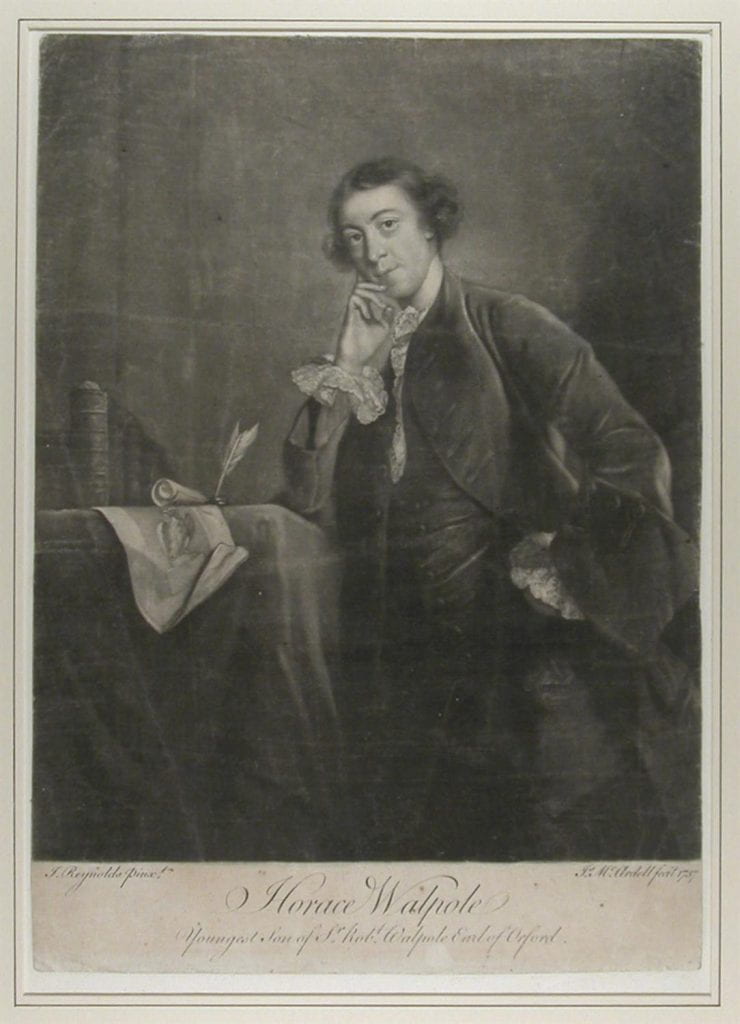

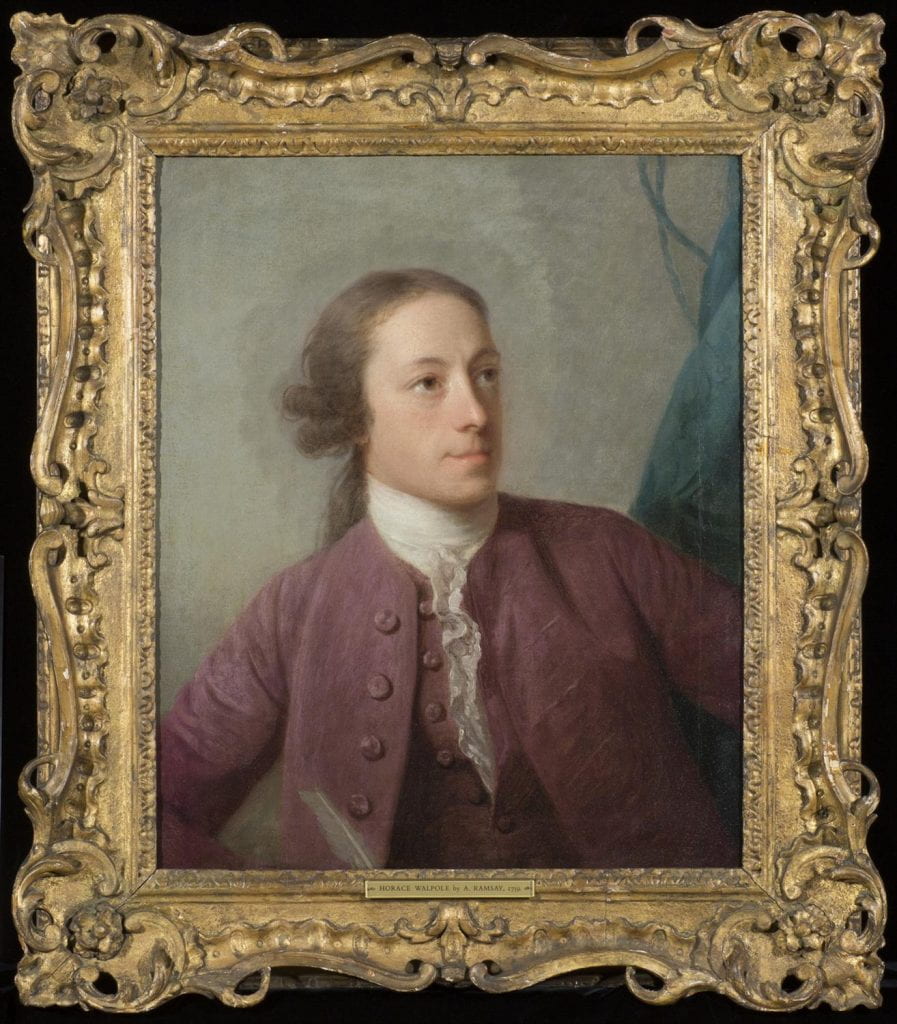
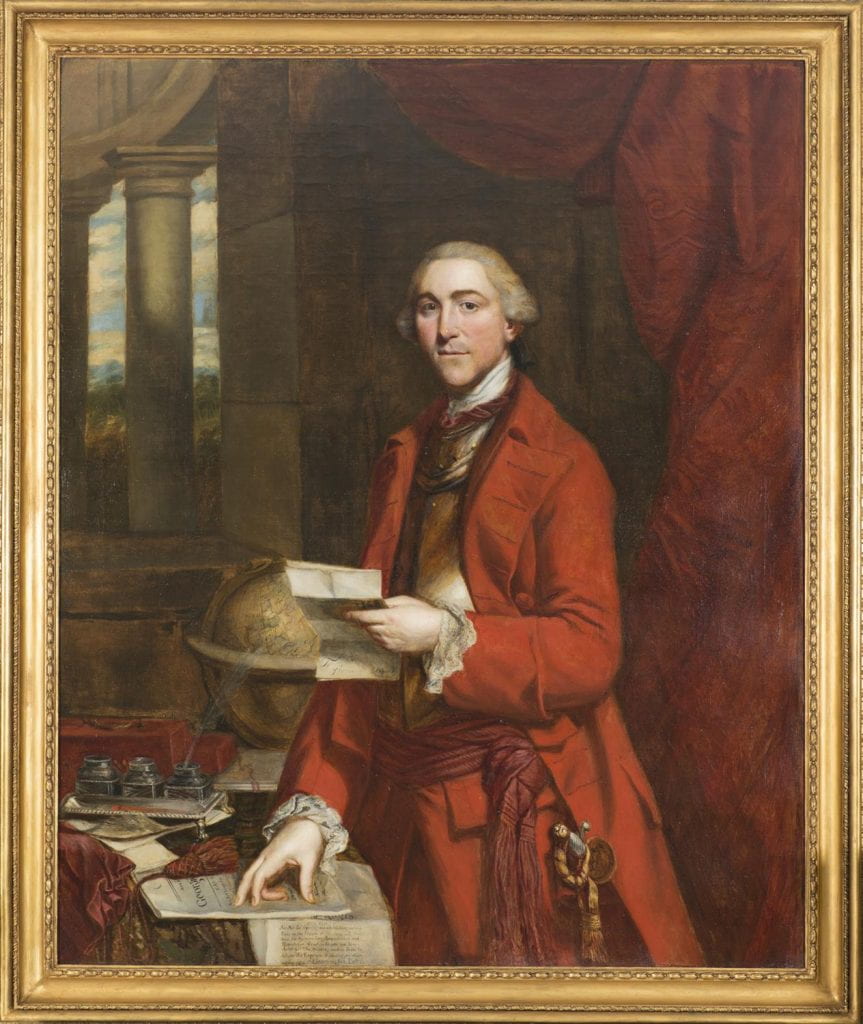
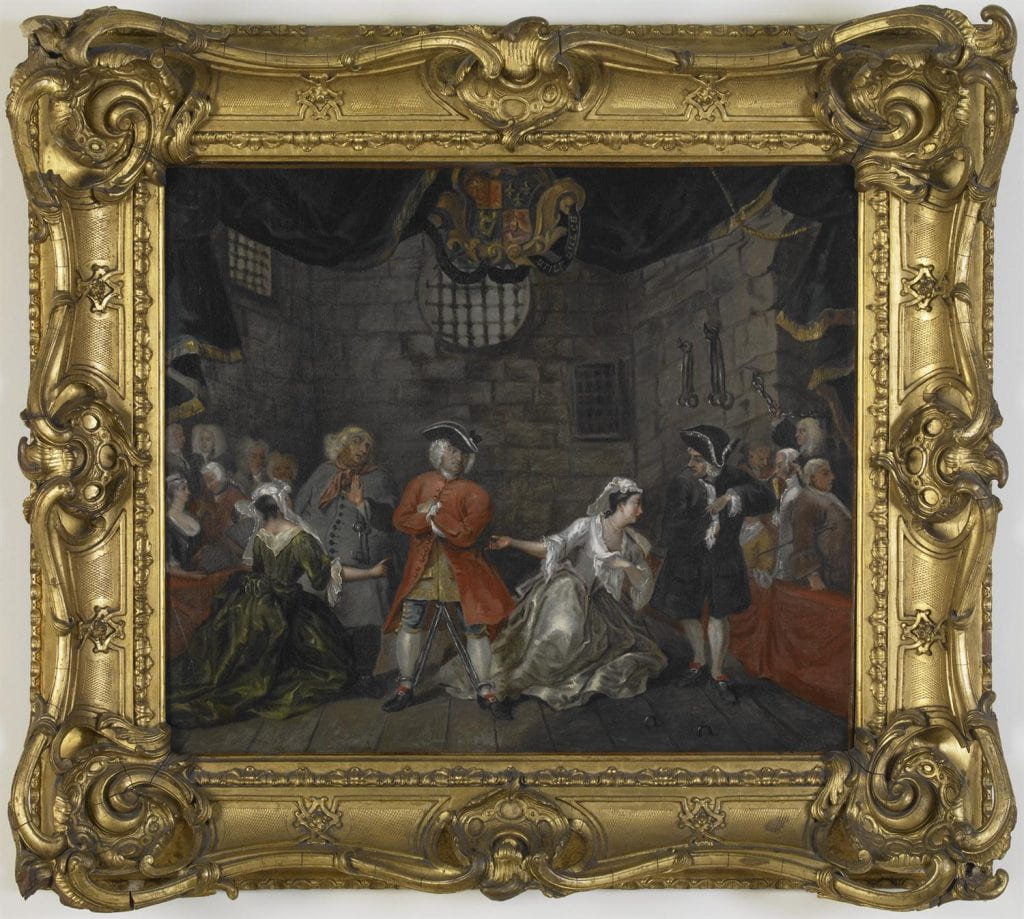
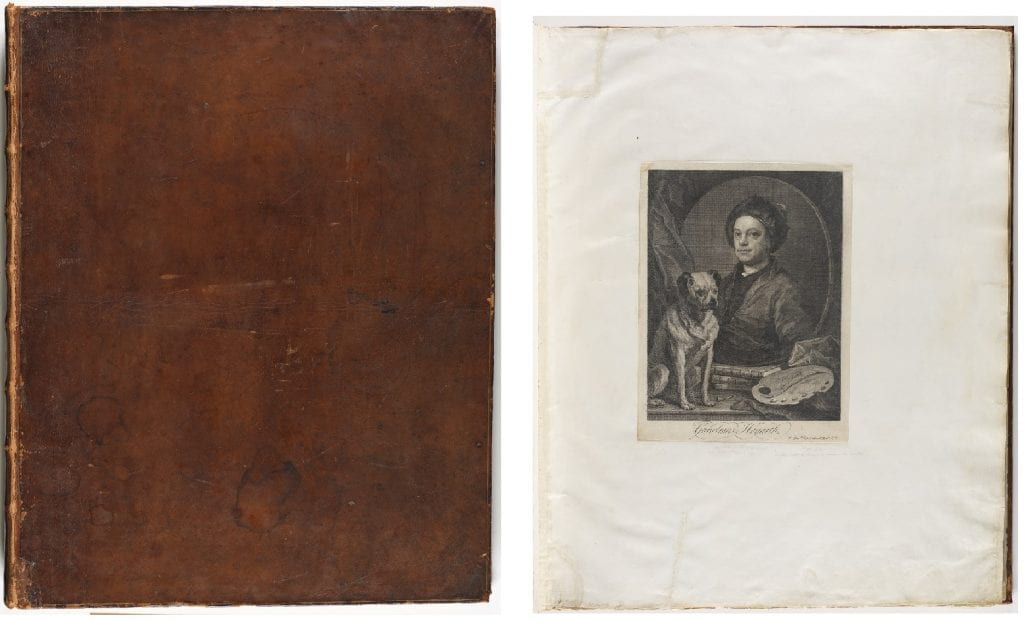

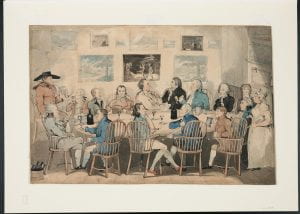
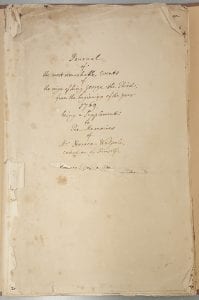
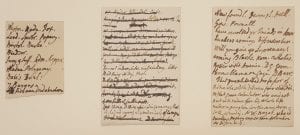
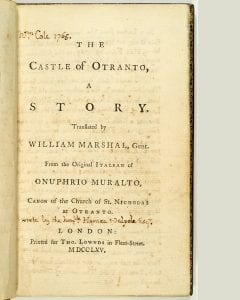
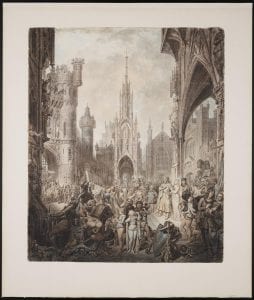
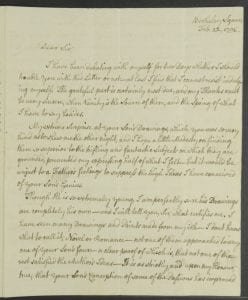









![Duchesse de Choisel, and Madame la Marquise Du Deffand [graphic] : (from the original formerly at Strawberry Hill) / M. Carmontel, del. ; W. Greatbach sculp.](https://campuspress.yale.edu/walpole300/files/2018/07/Mme-du-deffand-29lufgd-199x300.jpg)
